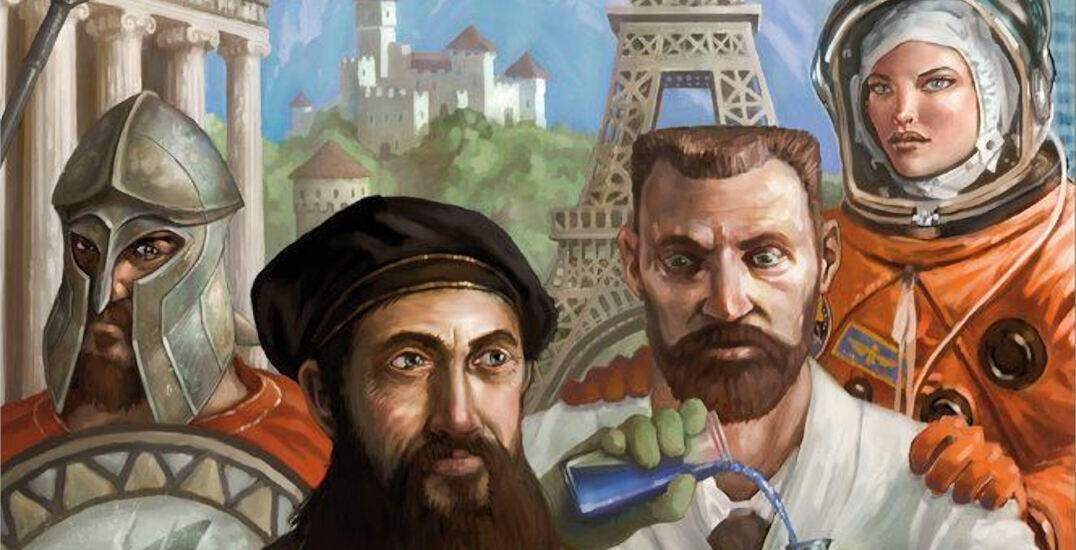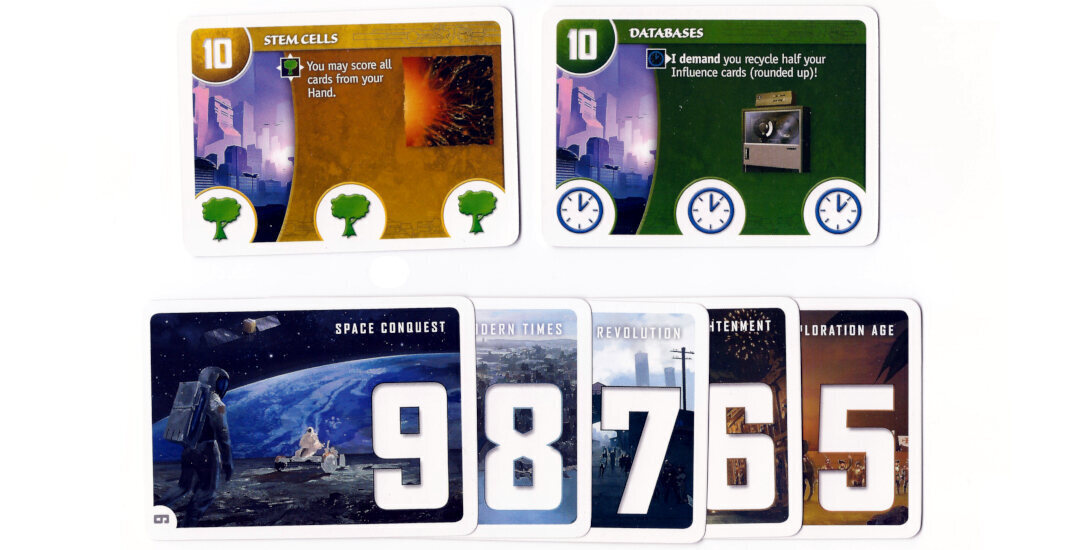
If I were a game designer, I would like to make a game like Innovation. Inside its small package, lies a clever civilization game where each card has its own ludicrous effect. It’s the kind of title I would be happy to play a hundred times and whose chaotic nature only furthers my enjoyment.
ACTIONS
In Innovation we have ten small decks. Each represents a different era of history, starting with humanity’s first steps and ending with the Digital Age. Our goal is to rise through them, drawing more and more powerful cards, until we dominate our opponents.
The way this works is very simple. In each turn we have exactly two actions. We may spend them to either draw a card, play it or use it. Cards allow us to draw better cards, develop our civilization by tucking them under each other and score. Of course, they also allow us to attack our opponents in a myriad of ways, from taking away their cards to destroying their score.
What makes Innovation tick is that all cards are extremely strong. The invention of the wheel doubles our civilization’s draw rate and it all gets better from there. Jumping whole eras, replacing our entire hand with the score pile and forcing our opponent to recycle their boards are a common occurrence in this game.
Innovation has one of the highest power levels in boardgaming. It’s a far cry from the subdued effects of Terraforming Mars and probably closer to Cosmic Encounter or Food Chain Magnate. It’s a refreshing approach after years of replaceable +1/-1 effects and a huge part of the game’s identity.
 A higher power level might not equate to a better game but it keeps things exciting. It means every action has an impact. It’s easier to care about a sweeping scoring opportunity than a bonus point on every card. Above all, powerful effects are fun on their own terms.
A higher power level might not equate to a better game but it keeps things exciting. It means every action has an impact. It’s easier to care about a sweeping scoring opportunity than a bonus point on every card. Above all, powerful effects are fun on their own terms.
DEVELOPMENT
But Innovation is not all about powerful abilities. It has a bit of development to it, which keeps games grounded. Cards have a series of symbols and we may stack them together to increase our strength in say, science or industry. Properly developing our board may not seem necessary at first, but it’s vital to win.
All actions in Innovation fall into two categories: Supremacy and Cooperative. The first force our opponents to follow them if they don’t have as many symbols as us. The second makes us share the ability if they do. Put together, this makes us pay closer attention to what our opponents do on their side of the board.
The other side to development is scoring. Most games will be won by “dominating” eras which requires players a score equal to five times their value. This means it’s not enough to reach the end game and score a million points at once, we must actively pursue scoring from the outset.
This leads to an interesting self-balancing mechanism: It’s impossible to do well on all counts. Spending actions reaching newer eras inevitably means getting behind in either the board or scoring. Knowing when to push forward and when to stand back and increase our resources is a vital skill. It’s an interesting challenge that extends beyond cardplay.

Ultimately, what makes Innovation interesting is that it’s interactive. It’s not a blind race to game-breaking combos. Rather, it’s a fight where we try to abuse powerful effects before our opponent takes them away. I always care about my opponent’s actions, their symbols and development.
CHAOS
Still, Innovation is chaotic. Our position – and our opponent’s – changes with every card. Our board may be taken away, improved or turned into victory points. An engine can become obsolete or crumble. We have to reevaluate the board at every turn or risk wasting our two only actions.
In this sense, Innovation is a heavily tactical experience. While there are long-term implications to the game, it’s difficult to plan too much in advance. Rather, the larger difficulty lies in evaluating the board: How does each effect change the board? Is our engine pushing forward or simply stalling? Which path should we take?
Chudyk was perceptive and designed the game’s cards to be self-defeating. For example, The Wheel allows us to draw two cards per activation, but it only draws off the lowest available deck. A successful Piracy campaign may whittle down our opponents but becomes useless when they don’t have anything left to steal.
Another smart trick by Chudyk was to make all the cards a bit narrow. Most effects can’t be played blind. They either attack our opponents, score or draw cards only under certain conditions. They are powerful, but imperfect. To win, our engine must be greater than the sum of its cards.

Still, Innovation is not the type of game where the best player always wins. The game has enough randomness so as to make it difficult. It’s possible to draw poorly or find ourselves unable to fight our opponents before they run away with the game. But, win or lose, I always feel I could have done better.
BOX
Innovation comes in a small box. It’s a humble yet well-made production, enough to fit great player aids and the game’s 110 cards. Text is concise and simple with none of the verbose friendliness that brings down other titles. And while the cards may not be the prettiest or most recognizable, they do their job.
The main issue in this regard is that each card has two illustrations. The first depicts the era the card belongs to, the second encapsulates the actual technology. But since the former is much larger than the latter and is repeated in all cards of the same number, they are hard to tell apart. It would have been better to do away with it entirely and leave the technology to be.
Still, a lack of better artwork has not proven an obstacle. I would happily play Innovation a hundred times because it’s the quality of its gameplay that keep it engaging. In fact, the IELLO edition favourably tweaked the game’s balance, doing away with some of the most overpowered cards. Sadly, a couple changes went too far and now Oars is practically useless.
Even then, the game’s short play time makes it easy to forgive a bad match. It plays best with two and three, and the chaotic nature of the four player game can be toned down thanks to the official team rules. It’s still not the greatest player count, especially not with newbies, but it’s worth a look. Either way, Innovation is a fantastic experience and very much worth playing.
| INNOVATION (2010) | |||
|---|---|---|---|
| DESIGN | Carl Chudyk | ART | Cyril van der Haegen Robin Olausson Christophe Swal |
| PUBLISHER | Iello | LENGTH | 50 minutes |
| NUMBER OF PLAYERS | 2-4 (Best with 2-3) | SCORE | ★★★★ |



